#bramble hawthorne
Photo




Team RAIN - Pages 916-919
Links: Previous · Next · All Pages · Webtoon · Wikia · Send me a message/question!
Back in August 2021, I asked around for some OCs I could include in this chapter, and lo they be;
@danzene‘s Haema Oxblood
@furubatsu ‘s Almand Prun & Sienna Sard
@fallentitan98‘s Ava Coolwind
With Avon in the capable hands of Lucero Hawthorne, Chapter 3 draws to a close. Unfortunately this appears to be where RAIN ends, but I hope to at least finish the scripts and share those if people are interested.
#rwby#rwby art#rwby fan art#rwby oc#rwby original character#oc#rwby fanart#art#fanart#Haema Oxblood#Almand Prun#Sienna Sard#Ava Coolwind#Peach Vermell#jin-shi pan#viola braith#nyssa noirette#irving hawthorne#bramble hawthorne#lucero hawthorne
36 notes
·
View notes
Photo

Flynn padding along The Secret Path through the woods
#it's not really secret#but the entrance is hidden behind a wall of hawthorn trees bracken & brambles#we've been walking here over half a decade now & in all that time we've passed people on no more than 3 occasions#I find footprints & the path remains somewhat clear... so clearly others are using it but we never bump into them#flynn#border collie#dog#woods#woodland#england
110 notes
·
View notes
Video
n216_w1150 by Biodiversity Heritage Library
Via Flickr:
A new British flora;. London,Gresham Pub. Co.,1919.. biodiversitylibrary.org/page/11453133
#Floras#Great Britain#Plants#Wild flowers#New York Botanical Garden#LuEsther T. Mertz Library#bhl:page=11453133#dc:identifier=https://biodiversitylibrary.org/page/11453133#Bramble#Rubis rusticanus#Merc.#Barren Strawberry#Potentilla sterilis#Garcke#Dog Rose#Rosa canina#L.#Crab Apple#Pyrus Malus#Hawthorn#Cratagus#Cratagus Oxyancantha#Bryony#Bryonia dioica#Jacq.#flickr
2 notes
·
View notes
Text
May 2024 witch guide
Full moon: May 23rd
New moon: May 7th
Sabbats: Beltane-May1st
May Flower Moon
Known as: Bright Moon, Budding Moon, Dyad Moon, Egg Laying Moon, Frog Moon, Hare Moon, Leaf Budding Moon, Merry Moon, Moon of the Shedding Ponies, Planting Moon, Sproutkale, Thrimilcmonath & Winnemanoth
Element: Fire
Zodiac: Taurus & Gemini
Nature spirits: Elves & Faeries
Deities: Aphrodite, Artemis, Bast, Cernunnos, Diana, Frigga, Flora, Horned God, Kali, Maia, Pan, Priapus & Venus
Animals: Cat, leopard & lynx
Birds: Dove, Swallow & Swan
Trees: Hawthorne & rowan
Herbs: Cinnamon, dittany of Crete, Elder, mint, mugwort & thyme
Flowers: Foxglove, lily of the valley & rose
Scents: Rose & sandalwood
Stones: Amber, Apache tear, carnelian, emerald, garnet, malachite, rose quartz, ruby, tourmaline & tsavorite
Colors: Brown, green, orange, pink & yellow
Energy: Abundance, creative energy, faerie & spirit contact, fertility, intuition, love, marriage, material gains, money, propagation, prosperity, real-estate dealings, relationships & tenacity
May’s Flower Moon name should be no surprise; flowers spring forth across North America in abundance this month!
• “Flower Moon” has been attributed to Algonquin peoples, as confirmed by Christina Ruddy of The Algonquin Way Cultural Centre in Pikwakanagan, Ontario.
May’s Moon was also referred to as the “Month of Flowers” by Jonathan Carver in his 1798 publication, Travels Through the Interior Parts of North America: 1766, 1767, 1768 (pp. 250-252), as a likely Dakota name. Carver stayed with the Naudowessie (Dakota) over a period of time; his expedition covered the Great Lakes region, including the Wisconsin and Minnesota areas.
Beltane
Known as: Beltaine, May day, Roodmas & Cethsamhain
Season: Spring
Symbols: Eggs, faeries, fire, flowers & maypoles
Colors: Blue, dark yellow, green, light pink, orange, red, white yellow & rainbow spectrum
Oils/Incense: Frankincense, lilac, passion flower, rose, tuberose & vanilla
Animals: Bee, cattle, goat & rabbit
Mythical: Faeries
Stones: Bloodstone, emerald, lapis lazuli, orange carnelian, rose quartz & sapphire
Food: Beltane cakes, cherries, dairy foods, farls, green herbal salads, honey, meade, nuts, oat cakes, oats, strawberries & sweets
Herbs/Plants: Almond, ash tree, birch, bramble, cinquefoil, damiana, frankincense, hawthorn, ivy, meadowsweet, mushroom, rosemary, saffron, satyrion root, St.John's wort & woodruff
Flowers: Angelica, bluebell, daisy, hibiscus, honeysuckle, lilac, marigold, primrose, rose, rose hips & yellow cowslips
Trees: Ash, cedar, elder, fir, hawthorn, juniper, linden, mesquite, oak, pine, poplar, rowan & willow
Goddesses: Aphrodite, Areil, Artemis, Cybele, Danu, Diana, Dôn, Eiru, Elen, Eostre, Fand, Flidais, Flora, Freya, Frigga, Maia, Niwalen, Rhea, Rhiannon, Var, Venus & Xochiquetzal
Gods: Baal, Bacchnalia, Balder, Belanos, Belenus, Beli, Beltene, Cernunnos, Cupid, Faunus, Freyr, Grannus, The Green Man, Lares, Lugh, Manawyddan, Odin, Pan, Puck & Taranis
Issues, Intentions & Powers: Agriculture, creativity, fertility, lust, marriage, the otherworld/Underworld, pleasure, psychic ability, purification, sensuality, sex/uality, visions, warmth & youth
Spellwork: Birth, Earth magick, healing, health & pregnancy
Activities:
• Create a daisy chain or floral decorations
• Decorate & dance around a Maypole
• Set up an outdoor altar & leave offerings to faeries
• Prepare a ritual bath with fresh flowers
• Light a bonfire or candles & dance around them
• Set aside time for self care
• Gather flowers & use them to decorate your home or altar
• Prepare a feast to celebrate with friends/family
• Make flower crowns
• Bake bannocks, oat cakes or cookies
• Hang wreaths decorated with ribbons & flowers
• Plant flowers in your garden
• Start a wish book/box/journal
• Go on a walk & gice thanks to nature⁸
• Cast fertility or a bunch spells
• Fill small baskets of flowers & small goodies, then leave them on your friends/neighbors doorstep as a gesture of goodwill & friendship
Beltane is mentioned in the earliest Irish literature and is associated with important events in Irish mythology. Also known as Cétshamhain ('first of summer'), it marked the beginning of summer & was when cattle were driven out to the summer pastures. Rituals were performed to protect cattle, people & crops, and to encourage growth. (Today, Witches who observe the Wheel of the Year celebrate Beltane as the height of Spring.)
Special bonfires were kindled, whose flames, smoke & ashes were deemed to have protective powers. The people and their cattle would walk around or between bonfires & sometimes leap over the flames or embers. All household fires would be doused & then re-lit from the Beltane bonfire.
These gatherings would be accompanied by a feast, and some of the food and drink would be offered to the aos sí. Doors, windows, byres and livestock would be decorated with yellow May flowers, perhaps because they evoked fire.
In parts of Ireland, people would make a May Bush: typically a thorn bush or branch decorated with flowers, ribbons, bright shells & rushlights. Holy wells were also visited, while Beltane dew was thought to bring beauty & maintain youthfulness.
• The aos sí (often referred to as spirits or fairies) were thought to be especially active at Beltane. Like Samhain, which lies directly opposite from Beltane on the Wheel of the Year, this was seen as a time when the veil between worlds was at its thinnest. At Samhain the veil between the worlds of the living & the dead is thin enough that we can connect & convene with our beloved dead, here at Beltane it’s the veil between the human world, and the world of faeries & nature spirits that has grown thin. Offerings would be left at the ancient faerie forts, the wells and in other sacred places in an effort to appease these nature spirits to ensure a successful growing season.
Some believe this is when The Goddess is now the Mother & the God is seen as the Green Man or the wild stag. It celebrates the symbolic union, mating or marriage of the Goddess & God & heralds in the coming summer months. It represents life rather than Samhain on the opposite side of the Wheel of the Year.
Other Celebrations:
• Rosealia- May 23rd
Rosalia or Rosaria was a festival of roses celebrated on various dates, primarily in May, but scattered through mid-July. The observance is sometimes called a rosatio ("rose-adornment") or the dies rosationis, "day of rose-adornment," & could be celebrated also with violets. As a commemoration of the dead, the rosatio developed from the custom of placing flowers at burial sites. It was among the extensive private religious practices by means of which the Romans cared for their dead, reflecting the value placed on tradition (mos maiorum, "the way of the ancestors"), family lineage & memorials ranging from simple inscriptions to grand public works. Several dates on the Roman calendar were set aside as public holidays or memorial days devoted to the dead.
Roses had funerary significance in Greece, but were particularly associated with death & entombment among the Romans. In Greece, roses appear on funerary steles & in epitaphs most often of girls. Flowers were traditional symbols of rejuvenation, rebirth &memory, with the red & purple of roses & violets felt to evoke the color of blood as a form of propitiation
Sources:
Farmersalmanac .com
Llewellyn's Complete Book of Correspondences by Sandra Kines
Wikipedia
A Witch's Book of Correspondences by Viktorija Briggs
Encyclopedia britannica
Llewellyn 2024 magical almanac Practical magic for everyday living
#witch guide#may 2024#flower moon#sabbat#wheel of the year#beltane#beltaine#witchblr#wiccablr#paganblr#witch community#witchcore#witchcraft#witches of tumblr#tumblr witch community#tumblr witches#moon magic#spellbook#grimoire#book of shadows#witch#traditional witchcraft#spellwork#beginner witch#baby witch#witch tips#witch tumblr#baby witch tips#GreenWitchcrafts#witch friends
412 notes
·
View notes
Text
Modern farmers and landowners, however, are prejudiced against scrub because it is considered unproductive. As a result it has been almost entirely eradicated from Britain. Scrubland is almost ubiquitously described as wasteland. It was not always so. In medieval times, scrub species were highly valued, and scrub was anything but a dirty name. The iron-rod stems of blackthorn were used for walking sticks and its fruit – sloes – for medicines and flavouring wine and gin. Brambles, like elder, produce edible berries that were also useful for dyes. Hawthorn makes good walking sticks, as well as tool handles, and was used for stock-proofing, and produces hawberries for preserves and sauces. Hazel was for hurdles, thatching spars, basketry, furniture and charcoal; willow for charcoal-making and basketry, cricket bats and medicine. Charcoal from alder and dogwood made gunpowder. Broom, of course, made excellent brooms. Juniper was for smoking meats and making pencils, its berries for distilling oil, and flavouring game and gin. Spindle was for skewers, toothpicks and baskets. Wych elm made bows, furniture and threshing floors. Birch provided cotton reels and bobbins, firewood, brooms and roofing thatch; its bark was for waterproofing and tanning. Birch wine, fermented from sap, was used as medicine and young birch leaves were a diuretic. From the dog rose came rosehips – which we now know are exceptionally high in vitamin C – for syrups, sauces and jellies. Gorse – known as ‘furze’ in Sussex – was fodder for animals and fuel for kilns and ovens. A buffer of thorny scrub was often encouraged around woodland to prevent the ingress of grazing animals. Place names like Thorndon, Thornden, Thornbury, Haslemere, Hazeldon, Spindleton, Hathern (hawthorn), Hatherdene, Brambleton, Barnham Broom, Broomhill, Broompark, pepper the map of Britain. Our own field names at Knepp recall the days when scrub was an asset – Benton’s Gorse, Broomers Corner, Broom Field, High Reeds, Cooper Reeds, Faggot Stack Plat, Bramble Field, Rushett’s, Rushall Field, Little Thornhill, Great Thornhill, Stub Mead, Barcover Furzefield, Swallows Furzefield, Coates’ Furzefield, Greenstreet Furzefield, Constable’s Furze, Pollardshill Furze, Old Furze Field, Furzefield Plat, Great Furzefield and lots of Little Furzefields.
Isabella Tree, Wilding: The Return of Nature to a British Farm
89 notes
·
View notes
Text
Cryptidclaw's WC Prefixes List!
Yall said you were interested in seeing it so here it is!
This is a collection of mostly Flora, Fauna, Rocks, and other such things that can be found in Britain since that’s where the books take place!
I also have other Prefixes that have to do with pelt colors and patterns as well!
Here’s a link to the doc if you dont want to expand a 650 word list on your Tumblr feed lol! the doc is also in my drive linked in my pined post!
below is the actual list! If there are any names you think I should add plz tell me!
EDIT: I will update the doc with new names as I come up with them or have them suggested to me, but I wont update the list on this post! Plz visit my doc for a more updated version!
Animals
Mammal
Badger
Bat
Bear
Beaver
Bison
Boar
Buck
Calf
Cow
Deer
Elk
Fawn
Ferret
Fox
Goat
Hare
Horse
Lamb
Lynx
Marten
Mole
Mouse
Otter
Rabbit
Rat
Seal
Sheep
Shrew
Squirrel
Stoat
Vole
Weasel
Wolf
Wolverine
Amphibians
Frog
Newt
Toad
Reptiles
Scale
Adder
Lizard
Snake
Turtle
Shell
Birds
Bird
Down
Feather
Albatross
Bittern
Buzzard
Chaffinch
Chick
Chicken
Coot
Cormorant
Corvid
Crane
Crow
Curlew
Dove
Duck
Dunlin
Eagle
Egret
Falcon
Finch
Gannet
Goose
Grouse
Gull
Hawk
Hen
Heron
Ibis
Jackdaw
Jay
Kestrel
Kite
Lark
Magpie
Mallard
Merlin
Mockingbird
Murrelet
Nightingale
Osprey
Owl
Partridge
Pelican
Peregrine
Petrel
Pheasant
Pigeon
Plover
Puffin
Quail
Raven
Robin
Rook
Rooster
Ruff
Shrike
Snipe
Sparrow
Starling
Stork
Swallow
Swan
Swift
Tern
Thrasher
Thrush
Vulture
Warbler
Whimbrel
Wren
Freshwater Fish
Fish
Bass
Bream
Carp
Dace
Eel
Lamprey
Loach
Minnow
Perch
Pike
Rudd
Salmon
Sterlet
Tench
Trout
Roach
Saltwater fish and other Sea creatures (would cats be able to find some of these? Probably not, I don't care tho)
Alge
Barnacle
Bass (Saltwater version)
Bream (Saltwater version)
Brill
Clam
Cod
Crab
Dolphin
Eel (Saltwater version)
Flounder
Garfish
Halibut
Kelp
Lobster
Mackerel
Mollusk
Orca
Prawn
Ray
Seal
Shark
Shrimp
Starfish
Sting
Urchin
Whale
Insects and Arachnids
Honey
Insect
Web
Ant
Bee
Beetle
Bug
Butterfly
Caterpillar
Cricket
Damselfly
Dragonfly
Fly
Grasshopper
Grub
Hornet
Maggot
Moth
Spider
Wasp
Worm
Trees
Acorn
Bark
Branch
Forest
Hollow
Log
Root
Stump
Timber
Tree
Twig
Wood
Alder
Apple
Ash
Aspen
Beech
Birch
Cedar
Cherry
Chestnut
Cypress
Elm
Fir
Hawthorn
Hazel
Hemlock
Linden
Maple
Oak
Pear
Poplar
Rowan
Redwood
Spruce
Willow
Yew
Flowers, Shrubs and Other plants
Berry
Blossom
Briar
Field
Flower
Leaf
Meadow
Needle
Petal
Shrub
Stem
Thicket
Thorn
Vine
Anemone
Apricot
Barley
Bellflower
Bluebell
Borage
Bracken
Bramble
Briar
Burnet
Buttercup
Campion
Chamomile
Chanterelle
Chicory
Clover
Cornflower
Daffodil
Daisy
Dandelion
Dogwood
Fallow
Fennel
Fern
Flax
Foxglove
Furze
Garlic
Ginger
Gorse
Grass
Hay
Heather
Holly
Honeysuckle
Hop
Hyacinth
Iris
Ivy
Juniper
Lavender
Lichen
Lilac
Lilly
Mallow
Marigold
Mint
Mistletoe
Moss
Moss
Mushroom
Nettle
Nightshade
Oat
Olive
Orchid
Parsley
Periwinkle
Pine
Poppy
Primrose
Privet
Raspberry
Reed
Reedmace
Rose
Rush
Rye
Saffron
Sage
Sedge
Seed
Snowdrop
Spindle
Strawberry
Tangerine
Tansy
Teasel
Thistle
Thrift
Thyme
Violet
Weed
Wheat
Woodruff
Yarrow
Rocks and earth
Agate
Amber
Amethyst
Arch
Basalt
Bounder
Cave
Chalk
Coal
Copper
Dirt
Dust
Flint
Garnet
Gold
Granite
Hill
Iron
Jagged
Jet
Mountain
Mud
Peak
Pebble
Pinnacle
Pit
Quartz
Ridge
Rock
Rubble
Ruby
Rust(y)
Sand
Sapphire
Sediment
Silt
Silver
Slate
Soil
Spire
Stone
Trench
Zircon
Water Formations
Bay
Cove
Creek
Delta
Lake
Marsh
Ocean
Pool
Puddle
River
Sea
Water
Weather and such
Autumn
Avalanche
Balmy
Blaze
Blizzard
Breeze
Burnt
Chill
Cinder
Cloud
Cold
Dew
Drift
Drizzle
Drought
Dry
Ember
Fall
Fire
Flame
Flood
Fog
Freeze
Frost
Frozen
Gale
Gust
Hail
Ice
Icicle
Lightening
Mist
Muggy
Rain
Scorch
Singe
Sky
Sleet
Sloe
Smoke
Snow
Snowflake
Soot
Sorrel
Spark
Spring
Steam
Storm
Summer
Sun
Thunder
Water
Wave
Wet
Wind
Winter
Celestial??
Comet
Dawn
Dusk
Evening
Midnight
Moon
Morning
Night
Noon
Twilight
Cat Features, Traits, and Misc.
Azure
Beige
Big
Black
Blonde
Blotch(ed)
Blue
Bounce
Bright
Brindle
Broken
Bronze
Brown
Bumble
Burgundy
Call
Carmine
Claw
Cobalt
Cream
Crimson
Cry
Curl(y)
Dapple
Dark
Dot(ted)
Dusky
Ebony
Echo
Fallen
Fleck(ed)
Fluffy
Freckle
Ginger
Golden
Gray
Green
Heavy
Kink
Knot(ted)
Light
Little
Lost
Loud
Marbled
Mew
Milk
Mottle
Mumble
Ochre
Odd
One
Orange
Pale
Patch(ed)
Pounce
Prickle
Ragged
Red
Ripple
Rough
Rugged
Russet
Scarlet
Shade
Shaggy
Sharp
Shimmer
Shining
Small
Smudge
Soft
Song
Speckle
Spike
Splash
Spot(ted)
Streak
Stripe(d)
Strong
Stump(y)
Sweet
Tall
Talon
Tangle
Tatter(ed)
Tawny
Tiny
Tough
Tumble
Twist
Violet
Whisker
Whisper
White
Wild
Wooly
Yellow
#cryptidclaw's warriors au#?#Im tempted to use these in the au#some characters deserve some more fun names hehe#rise of change#warrior cats#warrior cats design#warriors#warriors names#warriors naming#warriors prefixes
543 notes
·
View notes
Text
Hawthorn
I am the first to affectionately call Canach a cactus - and it is fitting! both physically and in terms of his prickly character - BUT! Allow me to bring forth an alternative!
Canach is not a cactus. He is a hawthorn.
As a sapling, Canach arboured light green bark, and white leaves / petals, his features remarkably devoid of thorns.
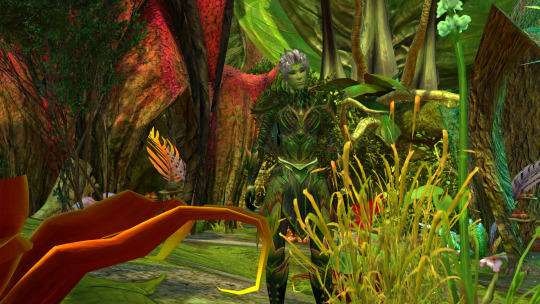
Come a few years and a few hardship, and there's Canach as we now know him, his bark turned dark grey and quite a few thorns marring his features.

And now for the comparison. Hawthorn.
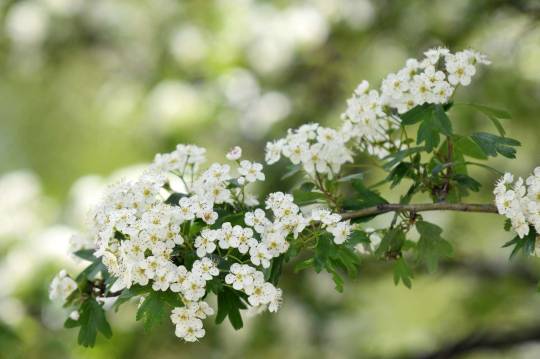

As for how far as the comparison goes...
Hawthorns are shrubs, or small trees.
Their bark is dull brown with vertical orange cracks.

The name itself is derived from the anglo-saxon word 'haguthorn' meaning "wall of thorns".
"The bramble walls were a stroke of genius. If I do say so myself."
And as for the symbolism of hawthorn, they are associated with protection and isolation, thriving in defensive, thorny hedges, and as solitary trees, with love and renewal, blooming in may, and with death.
43 notes
·
View notes
Photo


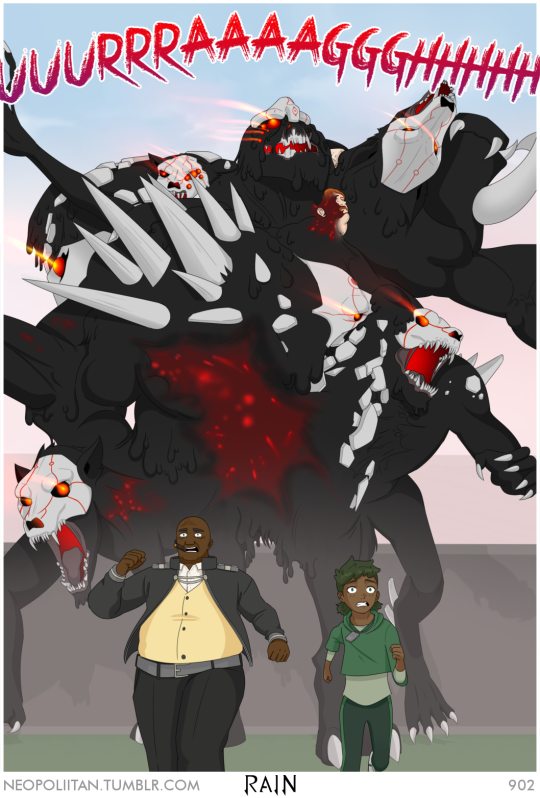
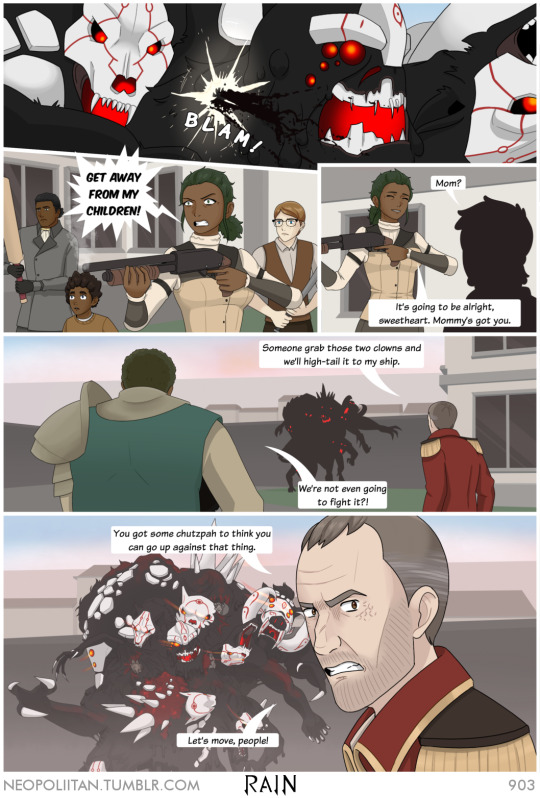
Team RAIN - Pages 900-903
Links: Previous · Next · All Pages · Webtoon · Wikia · Send me a message/question!
Let’s be honest, this was always the logical conclusion of turning grimm into liquid. Mix that liquid up, and it’ll congeal together to form...
THE RAT KING
#rwby#rwby art#rwby fan art#rwby oc#rwby original character#oc#rwby fanart#art#fanart#viola braith#raleigh radcliff#irving hawthorne#zydra sky#glimmer oliviera#nyssa noirette#farran hawthorne#Ivy Hawthorne#lloyd hawthorne#bramble hawthorne#magnolia hawthorne#castan armona
23 notes
·
View notes
Text
Moth of the Week
Peppered Moth
Biston betularia

The peppered moth is a part of the family geometridae. It was first described in 1758 by Charles Linnaeus. This moth gains its name from its speckled coloration, which has been studied as an example of natural selection and population evolution.
Description This species has a short body with narrow forewings. The body and wings are the same white base peppered with black dots and irregular black lines. This speckled pattern may vary with some moths having very few spots and others having so many that they look as if they are black with white spots as opposed to white with black. In rare cases, the black on the wings and body is replaced with gray or brown and in even rarer cases the spots are a combination of brown and black/gray. These spots help the moth camouflage against lichen on trees.
The evolution of this moth had been studied extensively during the last two hundred years, which created the term “industrial melanism.” During the Industrial Revolution, air pollution killed off lichen and covered trees in soot. This caused moths with a black spots on white base (typica) coloration to lose their camouflage and die off due to predators. This caused a spike in population for moths with a darker coloration (carbonaria) because they had the camouflage advantage. Once environmental conditions improved, the lighter colored moths once again became the dominant coloration.
The male’s antennae are bipectinate, meaning it has two rows of rami going down either side of a singular flagellum.
Wingspan Range: 45 - 62 mm (≈1.77 - 2.44 in)
Diet and Habitat The caterpillar of this moth eats many trees, shrubs, and small plants such as Blackthorn (Prunus spinosa), Hawthorn (Crataegus monogyna), Downy (Betula pubescens) and Silver Birch (Betula pendula), limes, sallows, poplars, oaks, Sweet Chestnut (Castanae sativa), Beech (Fagus sylvatica), Bramble (Rubus fruiticosus), Broom (Cytisus scoparius), Black Currant (Ribes nigrum) and Hop (Humulus lupulus).
They have a wide range, being found in China (Heilongjiang, Jilin, Inner Mongolia, Beijing, Hebei, Shanxi, Shandong, Henan, Shaanxi, Ningxia, Gansu, Qinghai, Xinjiang, Fujian, Sichuan, Yunnan, Tibet), Russia, Mongolia, Japan, North Korea, South Korea, Nepal, Kazakhstan, Kyrgyzstan, Turkmenistan, Georgia, Azerbaijan, Armenia, Europe and North America. They prefer habitats of woodland, scrub, hedgerows, parks and gardens.
Mating Depending on its location, this moth can have one or two generations per year. In Great Britain and Ireland, the peppered moth has one generation per year, whilst in south-eastern North America it has two generations per year. They emerge from the pupea in late May to August.
The females attract males with pheromones, which are carried by the wind. Males follow the concentration gradient to find the female. The male guards the female from other males until she lays the eggs. The female lays about 2,000 pale-green ovoid eggs about 1 mm in length into crevices in bark with her ovipositor.
Predators This species is a night-flying moth, making the vulnerable to bats. The males in particular fly every night to search for a female while females fly only the first night.
To protect themselves from birds during the day, this species rests on lichen covered trees to camouflage themselves.
The day time resting positions of this moth have been recorded and studied. This study shows that the peppered moth prefers resting spots that are covered such as below where the trunk and a branch meet, the underside of branches, and leafy twigs.
Additionally, the study found peppered moths with a lighter coloration (typica) blend in better against crustose lichens rather than foliose lichens because birds can see ultraviolet light. The peppered moth reflects UV light while crustose lichens don’t, making them easier to pick out.
Fun Fact The caterpillars of the peppered moth resemble things in both color and size. An experiment published in 2019 done on the caterpillars of the peppered moth showed that the larva (even when blindfolded) could sense the color of the tree they live on and change their body color to match and/or would move to a different twig that was closest in color to their own body.
(Source: Wikipedia, Butterfly Conservation, Max Planck Institute)
#Biston betularia#libraryofmoths#animals#bugs#facts#insects#moth#lepidoptera#mothoftheweek#Geometridae#peppered moth
86 notes
·
View notes
Text
🌿Inviting Birds Into Your Garden🐦
Birds are essential to a healthy ecosystem, but not everyone takes kindly to them in their gardens. Birds love to eat berries, peck holes in fruits, and scratch up seedlings, but in the permaculture garden we strive to partner with nature to meet the needs of wildlife AND ourselves. Growing food for ourselves at the expense of wildlife has resulted, in part, in the current global food system that doesn't value the humans involved or the ecosystem.
"By attracting birds, small animals, and insects to our yards, we not only increase biodiversity but make our gardens more balanced, disease free, and productive as well." -Toby Hemenway, Gaia's Garden: A Guide to Small-Scale Permaculture
Benefits of a Bird-Friendly Garden
Birds are beautiful! Watching them enjoy your gardens and learning bird language is rewarding and entertaining
Birds keep insect problems in check
Birds loosen the soil as they forage and scratch
Birds provide natural fertilizer
The Combination that Works
"Creating a garden that your winged friends want to call home is easy. You'll need to provide food, water, and shelter. Any of these elements will bring birds to your garden for a visit. But providing all three will make them more inclined to take up residence." -Kris Bordessa, Attainable Sustainable: The Lost Art of Self-Reliant Living
Keep in mind that birds have different needs! Not all birds eat the same things and their nesting habits vary. So the real key is diversity! Plant a variety of plant types, textures, heights, and seasons of value.
Food
Birds have a varied diet of fruit/berries, insects, and nuts/seeds. Some have more specific diets than others. Some forage for food on the ground and some hunt above ground.
Year-Round Bird Food Sources
Evergreen trees - Provide shelter, protection, and sap for food
Flowers, tall grasses, and herbs - Provide cover for ground feeders, seeds, nectar, and insects to forage
Fruits (late spring through summer) - Blueberries, brambles like blackberries or raspberries, cherries, elderberries, mulberries, serviceberries, and wild plum. Birds LOVE mulberries especially and having them available will help deter birds from your other crops
Fruits (fall) - Aronia berries, dogwood, sea buckthorn, buffaloberry. In fall birds need to build up fat reserves to survive winter, give them a fall buffet!
Fruits (winter) - These are fruits that cling to branches over winter. Crabapple, hardy kiwi, hawthorn, highbush cranberry, medlar, sumac
Nectar-producing plants for hummingbirds - Bee balm, lupine, sage, maple trees, black locust trees
Nuts - Butternut, chestnut, hazelnut, pickory, piñon, walnut. Offer protection, good nesting sites, and insects to forage
Choose plants native to your area!
2. Water
Birds love natural moving water like streams or ponds. Replicate this with a 2 inch deep bird bath with a fountain! Place your bird bath near a shrub so they have perches and an escape route nearby.
3. Shelter & Protection
Birds need shelter from the elements and protection from predators along with their food and water sources.
Tall grass, dense shrubs, tree canopy, and thorny plants act as a save haven. Birds also nest at different heights, so offer a variety of trees and shrubs for them to settle in.
More plant ideas that provide nesting sites, shelter, and protection:
Apple
Persimmon
Rose
Serviceberry
"Without animals, nature just limps along." -Toby Hemenway
Source
#permaculture#permaculture gardening#food forest#birds#gardening#birds in the garden#cottagecore#solarpunk#ecosystem
471 notes
·
View notes
Text
English Folk/Traditional Names for Common Plants & Herbs

These are known now as folk names, but back in the medieval era and well into the 18th century, these were the common names for some of the herbs and plants in use in witchcraft (and generally!) today.
This list is not an exhaustive one; the names given here are just some of the names that were used primarily in England for common plants within the region.These plants have other unique and wonderful names in many other cultures and languages throughout the world.
✧ ADDER’S TONGUE (Ophioglossum Vulgatum)
A.K.A.: English Adder’s Tongue, Snake’s Tongue, Viper’s Tongue, Serpent’s Tongue, Adder’s Spear, Christ’s Spear.
✧ AGRIMONY (Agrimonia Eupatoria)
A.K.A.: Harvest Lice, Cat’s Tail, Liverwort, Sticklewort, Stickwort, Stickweed, Fairy’s Wand, Church Steeples, Aaron’s Rod, Beggar’s Lice/Ticks.
✧ ALDER (Alnus Glutinosa)
A.K.A.: Black Alder, Fever Bush, Owler.
✧ ANGELICA (Angelica Archangelica)
A.K.A.: Holy Ghost/Root of the Holy Ghost, St. Michael’s flower, Angel’s Food.
✧ ANISE (Pimpinella Anisum)
A.K.A.: Sweet Alice, Aniseed.
✧ APPLE (Malus)
A.K.A.: Fruit of the Gods, Fruit of the Underworld, Silver Branch, Silver Bough.
✧ ASH (Fraxinus Excelsior)
A.K.A.: Bird’s Tongue, Hampshire Weed, Widow-maker, Venus of the Woods, Husbandman’s tree.
✧ BALSAM (Commiphora Opolbalsamum)
A.K.A.: Balsam of Gilead, Balm Tree, Mecca Myrrh.
✧ BASIL (Oscimum Basilicum)
A.K.A.: Our Herb, St. Joseph’s Wort, Witches’ Herb, King of Herbs, Holy Basil.
✧ BAY (Laurus Nobilis)
A.K.A.: Bay Laurel, True Laurel, Daphne, Noble Laurel.
✧ BERGAMOT (Monarda Didyma)
A.K.A.: Horsebalm, Bee Balm, Scarlet Mondara.
✧ BIRCH (Betula Pendula)
A.K.A.: Silver Birch, White Birch, Lady of the Woods.
✧ BITTERSWEET (Solanum Dulcamara)
A.K.A.: Woody Nightshade, Felon-wort, Felonwood, Blue Nightshade, Fever Twig, Staff Vine, Violet Bloom.
✧ BLACKBERRY (Rubus Fruticosus)
A.K.A.: Bramble, Fingerberry, Blackhide, Blackbutter, Thimbleberrym Brambleberry, Gouthead.
✧ BLUEBELL (Hyacinthoides Non Scrupta)
A.K.A.: Nodding Squill, Auld Man’s Bell, Ring-o-bells, Wood Bells.
✧ BROOM (Cytisus Scoparius)
A.K.A.: Besom, Irish Tops, Scotch Broom, Butcher’s Broom, Sweet Broom.
✧ BURDOCK (Arctium Lappa)
A.K.A.: Thorny Burr, Beggar’s Buttons, Sticky Bobs, Love Leaves, Hare Burr.
✧ CARNATION (Dianthus Caryophyllus)
A.K.A.: Gilliflower, July Flower, Clove Pink, Sops-in-wine.
✧ CHAMOMILE (Anthemis Nobilis)
A.K.A.: Whig Plant, Chamomel, Earth/Ground Apple,
✧ CHESTNUT [SWEET] (Castanea Sativa)
A.K.A.: Marion, Jupiter’s Nut.
✧ CHICKWEED (Stellaria Media)
A.K.A.: Starweed, Adder’s Mouth, Scarweed/wort, Tongue Grass, Stitchwort, White Bird’s Eye, Little Star Lady.
✧ CHICORY (Cichorium Intybus)
A.K.A.: Witloof, Blue Sailors, Coffeeweed.
✧ CLARY [WILD] (Salvia Verbenaca)
A.K.A.: Christ’s Eye, Wild Clear-eye, Vervain Sage, Eyeseed.
✧ CLEAVERS (Galium Aparine)
A.K.A.: Catchweed, Beggar Lice, Goose Grass, Sticky Willy, Bedstraw, Robin-run-the-hedge, Goose’s Hair, Hedge-burrs, Milk Sweet, Stick-a-back, Scratchweed, Barweed.
✧ COMFREY (Symphytum Officinale)
A.K.A.: Knitbone, Slippery Root, Blackwort, Bruisewort, Ass Ear.
✧ DAISY (Bellis Perennis)
A.K.A.: Day’s Eye, Poet’s Darling, Bachelor’s Buttons, Bairnwort, Billy Buttons, Boneflower, Margaret’s Herb.
✧ DANDELION (Taraxacum Officinale)
A.K.A.: Swine’s Snout, Blowball, Puffball, Clockflower, Tell-the-time, Priest’s Crown, Lion’s Tooth.
✧ DEADLY NIGHTSHADE (Atropa Belladonna)
A.K.A.: Belladonna, Banewort, Black-cherry, Devil’s Cherries, Naughty Man’s Cherries, Devil’s Herb.
✧ FEVERFEW (Tanacetum Parthenium)
A.K.A.: Featherfew, Featherfoil, Midsummer Daisy, Nosebleed.
✧ FOXGLOVE (Digitalis Purpurea)
A.K.A.: Fairy Gloves/Fingers/Petticoats/Thimbles/Weed, Witches’ Glove, Witches’ Bells, Our Lady’s Glove, Dead Men’s Bells.
✧ GARLIC (Allium Sativum)
A.K.A.: Poor Man’s Treacle, Stinkweed, Camphor of the Gods.
✧ GOLDENROD (Solidago Vibgaurea)
A.K.A.: Aaron’s Rod, Cast the Spear.
✧ HAWTHORN (Crataegus Monogyna)
A.K.A.: May Blossom, Mayflower, Whitethorn, Hagthorn, Ladies’ Meat.
✧ HELLEBORE [BLACK] (Helleborus Niger)
A.K.A.: Bear’s Foot, Setter-wort/grass.
✧ HEMLOCK (Conium Maculatum)
A.K.A.: Poison Hemlock, Devil’s Porridge.
✧ HENBANE (Hysoscyamus Niger)
A.K.A.: Hog Bean, Stinking Nightshade, Henbell, Devil’s Eye, Witches’ Herb, Devil’s Tobacco.
✧ HOLLY (Ibex Auifolium)
A.K.A.: Bat’s Wings, Holy Tree, Christ’s Thorn.
✧ HONEYSUCKLE (Lonicera Periclymenum)
A.K.A.: Woodbind, Fairy Trumpets, Sweet Suckle, Honeybind.
✧ HOREHOUND [BLACK] (Ballota Nigra)
A.K.A.: Madwort, Black Hoarhound, Black Archangel.
✧ HOREHOUND [WHITE] (Marrubium Vulgare)
A.K.A.: Bull’s Blood, White Archangel, Eye of the Star, Houndbane, Devil’s Eye.
✧ IVY (Hedera Helix)
A.K.A.: Gort, Bindwood, Lovestone.
✧ JUNIPER (Juniperus Communis)
A.K.A.: Bastard Killer, Gin Berry.
✧ LADY’S MANTLE (Alchemilla Vulgaris)
A.K.A.: Our Lady’s Mantle, Lion’s Foot, Bear’s Foot, Nine Hooks.
✧ LAVENDER (Lavendula Angustifolia)
A.K.A.: Elf Leaf, Spikenard, True Lavender.
✧ LEMON BALM (Melissa Officinalis)
A.K.A.: Sweet Melissa, Bee Balm, Sweet Balm.
✧ LEMON VERBENA (Aloysia Triphylla)
A.K.A.: Lemon Louisa, Lemon Beebrush.
✧ LILY OF THE VALLEY (Convallaria Majalis)
A.K.A.: May Lily, Our Lady’s Tears, Mary’s Tears, Ladder to Heaven.
✧ MALLOW (Malva Sylvestris)
A.K.A.: Cheese-cake, Pick-cheese, Round Dock, Wild Mallow, Wood Mallow.
✧ MANDRAKE (Mandragora Officinarum)
A.K.A.: Satan’s Apple, Love Plant, Mandragora.
✧ MARIGOLD (Calendula Officinalis)
A.K.A.: Bride of the Sun, Drunkard, Husbandman’s Dial, Mary Gold, Summer’s Bride.
✧ MARJORAM (Origanum Majorana)
A.K.A.: Wintersweet, Joy of the Mountain, Mountain Mint.
✧ MEADOWSWEET (Filipendula Ulmaria)
A.K.A.: Bridewort, Queen of the Meadows, Little Queen, Quaker Lady, Mead Sweet, Gravel Root.
✧ MINT [PEPPERMINT] (Mentha Piperita)
A.K.A.: Brandy Mint, English Mint.
✧ MINT [SPEARMINT] (Mentha Spicata)
A.K.A.: Garden Mint, Hart Mint, Our Lady’s Mint, Sage of Bethlehem.
✧ MISTLETOE (Viscum Coloratum)
A.K.A.: Druid’s Herb, Witches’ Broom, Wood of the Cross, Golden Bough, Devil’s Fuge.
✧ MONKSHOOD (Aconitum Napellus)
A.K.A.: Monk’s Blood, Blue Wolf’s-bane, Aconite, Women’s Bane, Devil’s Helmet, Friar’s Cap.
✧ MUGWORT (Artemisia Vulgaris)
A.K.A.: Lion’s Tail, Lion’s Tart, Heart-wort.
✧ MULLEIN (Verbascum Thapsus)
A.K.A.: Blanket/Velvet/Woolly Mullein, Our Lady’s Blanket, Beggar’s Blanket, Aaron’s Rod, Adam’s Rod, Jupiter’s Staff, Jacob’s Staff, Peter’s Staff, Virgin Mary’s Candle, Lady’s Foxglove, Graveyard Dust.
✧ NETTLE (Urtica Dioica)
A.K.A.: Stinging Nettle, Burn Weed, Burn Hazel.
✧ PARLSEY (Petroselinum Crispum)
A.K.A.: Devil’s Oatmeal, Persil.
✧ PENNYROYAL (Mentha Legium)
A.K.A.: Royal Thyme, Run-by-the-ground, Lurk-in-the-ditch, Pudding Grass.
✧ ROSEMARY (Rosemarinus Officinalis)
A.K.A.: Dew of the Sea, Sea Dew, Elf Leaf, Guardrobe, Rose of Mary.
✧ RUE (Ruta Graveolens)
A.K.A.: Herb of Grace, Herb of Repentance, Mother of Herbs.
✧ [CLARY] SAGE (Salvia Sclarea)
A.K.A.: Clear-Eye, See-bright, Eyebright.
✧ ST. JOHN’S WORT (Hypericum Perforatum)
A.K.A.: Scare-devil, Balm of the Warrior’s Wound, Rose of Sharon.
✧ SORREL (Rumex Acetose)
A.K.A.: Green Sauce, Sour Sauce, Cuckoo Sorrow.
✧ SWEET WOODRUFF (Galium Odoratum)
A.K.A.: Wild Baby’s Breath, Master of the Woods, Ladies in the Hay.
✧ TANSY (Tanacetum Vuulgare)
A.K.A.: Bitter Buttons, Golden Buttons, Cow Bitter.
✧ TARRAGON (Artemisia Dracunculus)
A.K.A.: Dragon’s Wort, Little Dragon.
✧ THISTLE [BLESSED] (Cnicus Benedictus)
A.K.A.: Holy Thistle.
✧ THISTLE [MILK] (Silybum Marianum)
A.K.A.: Our Lady’s Thistle, Saint Mary’s Thistle, Sow Thistle, Marian Thistle.
✧ VALERIAN (Valeriana Officinalis)
A.K.A.: Garden Heliotrope, St. George’s Herb, Bloody Butcher, Cat’s Valerian, Vandal Root.
✧ VERVAIN (Verbena Officinalis)
A.K.A.: Herb of Grace, Enchanter’s Herb, Britannica, Juno’s Tears, Divine Wood, Pigeongrass,
✧ WITCH HAZEL (Hamamelis Virginiana)
A.K.A.: Spotted Alder, Winterbloom, Snapping Hazelnut.
✧ WORMWOOD (Artemisia Absinthium)
A.K.A.: Absinthe, Crown for a King, Green Ginger.
✧ YARROW (Achillea Millefolium)
A.K.A.: Woundwort, Nose-Bleed, Thousand-Leaf, Arrowroot, Carpenter’s Weed, Devil’s Plaything, Devil’s Nettle,
Sources, References and Cross-Checks: Breverton's Complete Herbal (Terry Breverton), Encyclopedia of Magical Herbs (Scott Cunningham), Medieval Plant Names and Their Modern Corollaries (The Met Cloister).
If you like my content and would like to help me keep providing free stuff for my gorgeous Ghoul Gang, you can tip your witch here: [Paypal].
700 notes
·
View notes
Text
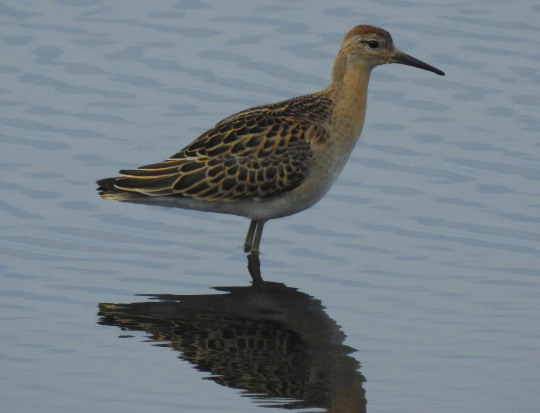


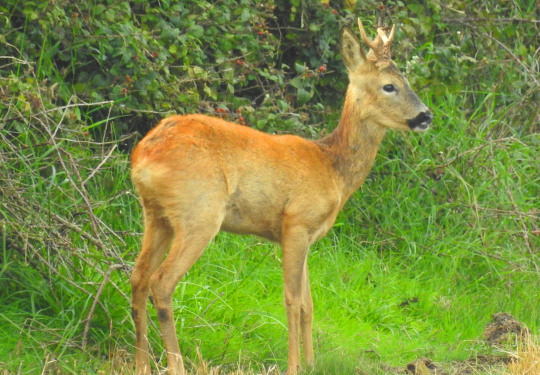


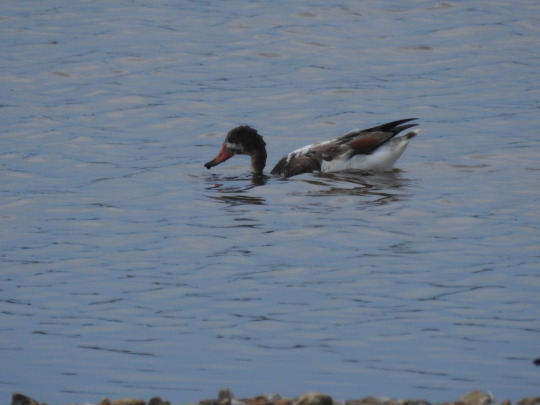
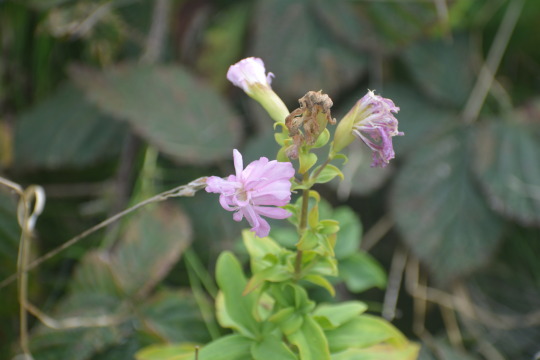


16/09/2023-Pennington
Flora and fauna photos taken in this set are of: 1. A neat and alluring Ruff we enjoyed watching wade in fishtail lagoon, a bird I love and we were lucky to get brilliant views of it. 2 and 10. A lovely Lapwing which we enjoyed closely nearby the Ruff, delightful to see its reflection. 3. Stunning Curlew Sandpipers. I was amazed to see seven of these prepossessing, distinctive and charming waders in the corner of fishtail lagoon, my Mum spotted eight. Some of these elegant birds had a nice rusty brown front. This is a bird we always feel extremely lucky if we can just see one of once in a year, in some previous years like this one we've seen them multiple times at coastal sites but we'd never seen so many at once before. This was sensational, a big moment in my autumn migration and birding year. 4. A nice Roe Deer we and some nice people we got chatting to enjoyed seeing. 5. Some of my first sea aster of the year, a very pretty flower and a key one here at this time of year. 6. Ringed Plover behind a Black-headed Gull on fishtail lagoon, it was good to see decent numbers of these today. 7. One of a few nice young Shelducks we saw. 8. Soapwort, a unique flower I like seeing here. 9. Blackberries.
It was brilliant to be back here seeing a great amount of birds, waders and ducks really shining today. Other highlights included many Dunlins, Little Stint, Knot, Redshank, Curlew, Oystercatcher, a fair few Black-tailed Godwits, beautiful Teal and Shoveler and Eiders offshore. Little Egret, Grey Heron, Great Crested Grebes, Redshank, Great Black-backed Gull, Starling, Whitethroat, Linnet, Pied Wagtail and Meadow Pipit were other avian highlights. I also enjoyed seeing butterflies Comma, Peacock and Small Heath well and Migrant Hawker the dragonfly of the moment for me. It was good to see bee on bramble flower, mossy rose gall, creeping thistle, creeping cinquefoil, musk mallow, possibly spurry, wild carrot, dock, gorse covered in a spider's web I'm seeing these well of late, rose hips and hawthorn.
#photography#birdwatching#curlew sandpiper#ruff#lapwing#oystercatcher#peacock#small heath#starling#comma#butterflies#birding#2023#pennington#lymington-keyhaven nature reserve#outdoors#weekend#saturday#meadow pipit#dunlin#ringed plover#exciting#waders#shelduck#shoveler#teal#ducks#redshank#wading birds#black-tailed godwit
32 notes
·
View notes
Text
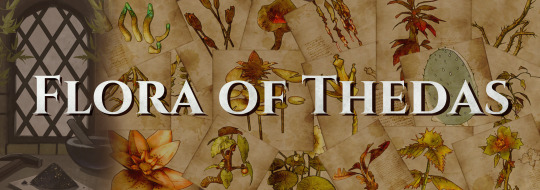
ALT
Flora of Thedas Master List
Master list of all the flora in Thedas, mentioned or seen.
Additional notes on certain items will be listed at the bottom, for items marked with asterisks, see the key below for a brief explanation and the Game assets and Additional Notes and Trivia section at the bottom. Sources are listed at the very end and this time linked.
For other lists here are posts for:
Real Plants in Thedas
Key:
* - Name comes from the asset file name
** - Name not provided but identified based on the textures used on the asset.
*** - See Additional Notes and Trivia.
General Flora: Flowers and Foliage
Acacia*: Black Wood*
Andraste's Grace
Ardent Blossom
Ash
Aspen
Banyan Tree*
Barbwood
Beech Tree
Belladonna
Birch: White Birch*
Blackthorn
Bluebell
Borage
Boswellia
Boxwood*
Buttercup
Cactus: Pear Cactus*
Cattail*
Cedar: Red Cedar
Chicory
Clover: Forest Clover*
Coleus**
Cosmos
Cotton
Crape Myrtle
Cypress: Italian Cypress*, Topiary Cypress*
Daffodil
Daisy: Marguerite
Dandelion
Dog-rose
Dogwood*
Elephant Ear*
Elm
Fade Berry*
Felicidus Aria
Fern: Red Fern*, Sword Fern*
Fir
Flax
Foxleaf*
Frangipani
Gorse
Harlot's Blush
Hawthorn
Hay
Hemp
Hensbane
Hero Tree*
Hollyhock
Honeysuckle
Iris
Ironbark
Ironwood***
Itchweed
Ivy
Jasmin
Larch
Lichen: Glowing Lichen
Lilac
Lily: Calla Lily**, Water Lily
Lotus
Maple
Marigold
Moss: Oakmoss, Redmoss, Tree-Moss
Nightshade
Northern Prickleweed
Oak: Serault Oak
Orchid
Palm Tree: Curly Palm*, Fan Palm*
Pansy
Peony
Pine: Chir Pine*, Stone Pine
Ponga Tree*
Poppy
Prickle-burrs
Redwood*
Rose: Climbing Rose
Rowan
Sandalwood
Seaweed
Snapdragon
Spruce
Sugar Cane
Sundew
Sunflower
Sylvanwood
Tahanis
Thistle
Trex*
Trullium
Vasanthum
Violet
Walnut: Black Walnut
Waterweed*
Wilds Flower
Willow
Witchhazel*
Wysteria
Yew
Fruits
Apple: Applewood Apple, Green Apple, Golden Apple, Red Apple
Apricot
Banana
Berries: Blackberry, Blueberry, Bramble Berry, Cranberry, Elderberry, Raspberry, Strawberry
Cherry
Citron
Coco, Chocolate
Coconut
Coffee
Currants: Black Currant
Fig
Grape
Lemon
Lime
Melon
Nuts: Almonds, Chestnut, Hognut, Peanuts
Olives
Orange: Sweet Orange
Palm Fruit: Date
Passion Fruit
Peach
Pear: Bradford Pear*
Plum
Pomegranate
Grains
Barley
Oats
Rice
Ryott
Wheat
Vegetables
Artichoke
Beans: Bush Bean, Green Bean, Pale Bean, White Bean
Beets
Bell Peppers: Red Bell Peppers
Cabbage
Capers
Carrot
Celery
Chive
Corn
Cucumber
Daikon Radish*
Eggplant
Fennel
Onion: Red Onion, Sweet Onion, White Onion
Pea
Peppers: Antivan Pepper, Green Pepper, Hot Pepper, Hot Red Pepper, Sweet Pepper
Potato
Radish
Spinach
Squash: Baby Pumpkin, Marrow Squash, Pumpkin, String Squash
Tomato
Turnip
Fungus of Thedas
Deep Mushrooms
Bleeding Russula
Blightcap
Blighted Morel
Brimstone Mushroom
Deep Mushroom
Destroying Spirit
Ghoul's Mushroom
Unnamed Mushroom Ortan Thaig
Surface Mushrooms
Beetle Spore
Drakevein
Field Mushroom
Gasbloom*
Sponge Root***
Toadstool
Truffle
Morel***
Unnamed Glowing Mushroom***
Unnamed Mushroom***
Spices
Allspice
Antivan Cord-Seed
Cardamom
Cinnamon
Clove
Cumin, Cumin Seed
Dill, Dill Seed
Juniper
Licorice
Mace
Mustard
Nutmeg
Pepper: Black Pepper
Peppercorn: Black Peppercorn
Saffron
Vanilla

ALT
Herbs of Thedas
Herbs count as anything that Dragon Age has classified as an herb (whether technically correct or not), plants that are used as herbs in real life. These do not include mushrooms, fungi, or deep mushrooms simply for ease of organization.
Amrita Vein
Andraste's Mantle
Arbor Blessing
Basil
Bay
Catsbane
Crystal Grace
Deathroot: Arcanist Deathroot, Lunatic's Deathroot
Dragonthorn
Elfroot/Canavaris: Bitter Elfroot, Gossamer Elfroot, Royal Elfroot
Embrium: Dark Embrium, Salubrious Embrium
Felandaris
Foxite
Garlic
Ghoul's Beard
Ginger
Heatherum
Lavender
Lotus: Black Lotus, Blood Lotus, Dawn Lotus
Madcap
Mint: Anderfel's Mint, Foxmint, Peppermint
Mintroot - Not a true mint based on its description and the fact that it grows on trees.
Oregano
Parsley
Prophet's Laurel
Rashvine
Rashvine Nettle
Redleaf
Rosemary
Sage
Spindleweed: Verdant Spindleweed
Stripweed
Thyme
Vandal Aria
Winterberry***
Witherstalk
Star Anise
Wormwood
Wormroot***
Game Assets Notes
These are plants shown in Dragon Age but aren't named in universe, just in their model files or through identification of the textures. Since most filler plant textures are just that of real world plants.
**NOTE:** When I mention they are not the known name of any plant, this comes with the caveat of being popular common names. Common names are highly variable and inconsistent. They depend on regional knowledge and association. Some travel farther than others. Common names are also not reliable identifiers.
Acacia: Black Wood
~ Note: Black Wood is a type of acacia. Both acacia and black wood are named assets.
Artichoke
~ Note: Identification comes from asset name, the artichoke flower is used as ornamentation of a box.
Banyan Tree
Boxwood
~ A type of shrub, identification comes from asset name.
Bradford Pear
~ Their fruits are edible, however their flowers are known to emit a smell akin to rotting meat. Identification comes from asset name.
Calla Lily
~ Note: Not named but identified by the texture used. It is seen in Val Royeaux planters.
Cattail
~ Note: Seen through out DAO and DAI, identification comes from asset name.
Coleus
~ Note: Not named but identified by the texture used. It is seen in Val Royeaux planters and in the Frostback Basin.
Crape Myrtle
Cypress: Italian Cypress, Topiary Cypress
~ Note: In terms of the Italian Cypress, in world it wouldl likely be called the "Antivan Cypress" given that Antiva is pulling from Italian culture, food, environments, and other inspirational elements. Cypress is a plant that is named in canon.
Daikon Radish
~ Note: Found on Dennet's farm, identification comes from asset name.
Dogwood
Elephant Ear
~ Note: Foliage found in the Frostback Basin, identification comes from asset name.
Fade Berry
Fern: Red Fern, Sword Fern
~ Note: The red fern isn't a real plant and therefore can be considered unique to Thedas. In contrast the sword fern is a real plant. Identification comes from the asset name for both of these ferns.
Forest Clover
Foxleaf
~ Note: This is another plant that is not real, no plant has this common name as far as I could find.
Gasbloom
~ Note: Seen in the Arbor Wilds, the Frostback Basin some elven ruins, and the elven ruins of multiplayer levels. Their identification comes from the asset name. There are two versions of the texture the "fixed" version is used in JoH dlc and thus explains the difference in appearance. This is not the name of a known mushroom.
Hero Tree
Palm: Curly Palm, Fan Palm
~ Note: Both palms are seen in the Frostback Basin, both are identified by their named assets.
Pear Cactus
~ Note: Found in the Frostback Basin, identification comes from the asset name.
Pine: Chir Pine
Ponga Tree
~ Note: Also known as the 'Tree Fern'. This is the tree you see in Val Royeaux garden as coming from Par Vollen, and throughout the Arbor Wilds.
Redwood
~ Note: Identified by the name of the file asset. Found in the Winter Palace, Exalted Plains, and on multiplayer maps.
Snapdragon
Trex
Waterweed
~ Note: In real life this is an entire genus not one particular plant. Though the six plants in this genus do share the common name of waterweed.
White Birch
Witchhazel
Additional Notes and Trivia
Ironwood - Unclear if this is an alternative name, the actual name of the plant, or both.
Morel - This mushroom is inferred due to the existence of Blighted Morel. However it is not explicitly specified there is a non-blighted morel.
Sponge Root - Though canonical as it is mentioned and shown in World of Thedas vol. 2 on pg. 138 with a collection of deep mushroom and surface mushroom illustrations. This mushroom was cut twice from Inquisition. It was cut from the base game as a craftable, it had a much different appearance from its final design, and then it was cut again from Trespasser. It does however still make an appearance in Inquisition as the inventory icon for Crystal Grace.
Unnamed Glowing Mushroom
Is mentioned in multiplayer when there are two Lukas playing.
Unnamed Mushroom
These brown mushrooms are seen in the Fallow Mire and the Frostback Basin. They are shown in two different sizes ranging from shorter than a dwarf to taller than one.
There is one unlisted mushroom, its assets is named "red mushroom" and thus is identified by textures. These is not a canon name but is included for completeness.
Amanita Muscaria: More commonly know as fly agaric or fly amanita, the red top with white spots is an iconic in its imagery. You will find large swaths of these mushrooms in the Frostback Basin. Their assets is named "Red Mushroom".
Winterberry is a real plant. However, from what we see in DA2, it does not the same as the plant we have in the real world, just a shared common name.
Wormroot is another real plant name. However, due to the description in The Calling, it does not seem to be the same plant. In The Calling it is used to treat the venom of a giant spider. The real world plant is used to treat parasites in the gut and does not seem to hold any shared uses in folk lore, folk medicine, or western medicine practices.
Sources
Dragon Age Origins + DLCs
Dragon Age 2
Dragon Age Last Court
Dragon Age Inquisition + DLCs
Dragon Age TTRPG Core Rulebook
Dragon Age TTRPG Blood of Ferelden
Dragon Age TTRPG: Creatures of Thedas: Wyvern
World of Thedas Vol. 1 and Vol. 2
Dragon Age: The Stolen Throne
Dragon Age: The Calling
Dragon Age: The Masked Empire
Dragon Age: Last Flight
Dragon Age: Tevinter Nights
Short Story: Paying the Ferryman
Short Story: Riddle in the Truth
Short Story: The Wake
Origins
Andraste's Grace
Codex: The Bercillian Forest
Codex: Falon'Din: Friend of the Dead, the Guide
Codex: Feast Day Fish
Codex: The History of Soldier's Peak: Chapter 3
Codex: Ironbark
Codex: A Note from the Honnleath Village Council
Codex: Sylaise: The Hearthkeeper
Codex: Sylvan
Codex: A Tattered Shopping List
Item: Concentrator Agent
Item: Deep Mushroom
Item: Figurine
Item: Madcap Bulb
Item: Rare Antivan Brandy
Item: Rashvine Nettle
Item: Spirit Charm
Item: Spirit Cord
Item: Sugar Cake
Item: Swift Salve
Item: West Hill Brandy
Item: Wilds Flower
DA 2
Ambrosia
Bianca (Crossbow)
Ironwood Clearing
Codex: Deathroot
Codex: Deep Mushroom
Codex: Embrium
Codex: Felandaris
Codex: The Hedge Witch
Codex: Spindleweed
Item: Carved Ironwood Buttons
Item: Harlot's Blush
Quest: Hard to Stomach
Quest: The Long Road
Quest: Tranquility
Weapon: The Celebrant
Weapon: Ironwood Shield
Weapon: Ironwood Warblade
Inquisition
Codex: Amrita Vein
Codex: Arbor Blessing
Codex: Avvar Cuisine
Codex: Black Lotus
Codex: Blood Lotus
Codex: Bottles of Thedas
Codex: Crystal Grace
Codex: Elfroot
Codex: Ghoul's Beard
Codex: The Girl in Red Crossing
Codex: Hard in Hightown Chapter 7
Codex: Hard in Hightown Chapter 10
Codex: Mediations and Odes to Bees
Codex: Notes on Palace Guests
Codex: The Orlesian Civil War
Codex: Prophet's Laurel
Codex: Rashvine
Codex: Rashvine Nettle
Codex: Vandal Aria
Codex: Vivienne's Alchemy Notes
Codex: Waterlogged Diary
Codex: Witherstalk
Note: Betta's Traveling Journal
Note: Carta Note on Security
Note: Field Notes
Note: The Gilded Horn's Drink List
Note: Knight-Captain's Orders
Note: Love Letter
Note: A Note from Skyhold's Kitchens
Note: A Note from Skyhold's Kitchens, Again
War Table: The Dance with the Dowager: The Allemande
Item: Ardent Blossom
Last Court
The Abbess' Road
The Anchoress
Arrival of the Divine
The Feast is Ending
Fires
Flames of Freedom
Good Neighbors
Heartwood Feast
The Hounds
The Lord of the Wood Comes a-Calling
The Purveyor of Teas
Road and River
A Swift Stream
Thieves!
Unofficial Meeting
Want to support this blog? Check out my ko-fi!
#dragon age#flora of thedas#herbs of thedas#writing resource#resource: plants#resource: flora#long post#lore#flora friday#floral friday
146 notes
·
View notes
Text
The Worst Bracket Begins!
Polls are going up starting Wednesday, April 19th, 32 per day! Bracket and list under the cut.
Round 1

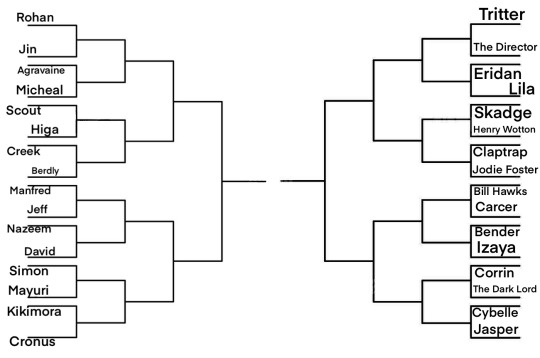

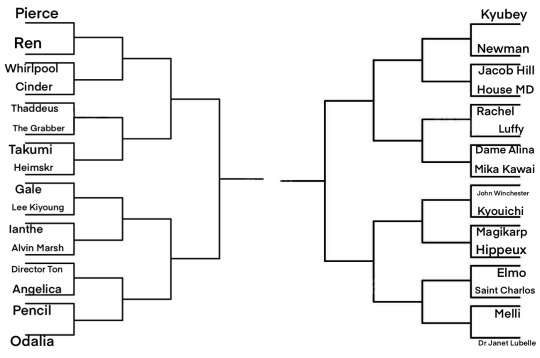

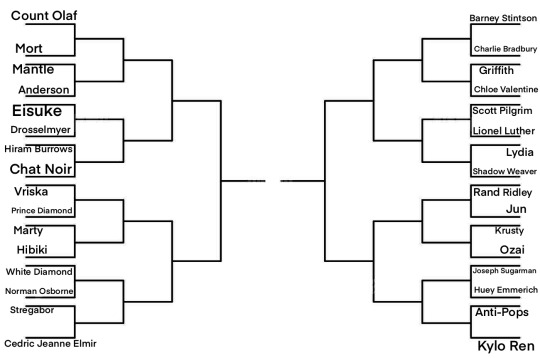
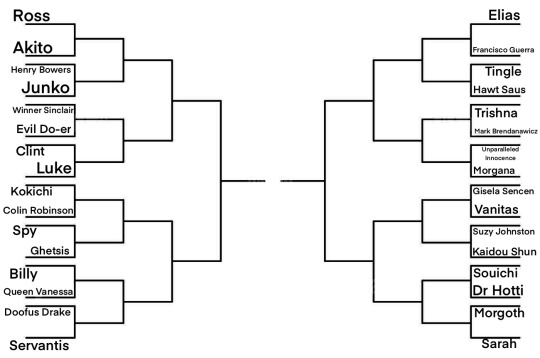

Bracket A (4/19-26)
Mineta Minoru (My Hero Academia) v Anglerfish from Dark Bramble (Outer Wilds)
Iago (Othello) v Barbas (Skyrim)
Brendan (Pokemon Ruby/Sapphire/Emerald) v Mimic (Dark Souls)
Dan (Dan vs) v Pink Diamond (Steven Universe)
Jurgen Litner (The Magnus Archives) v Lily Tucker-Pritchett (Modern Family)
Lonnie Byers (Stranger Things) v Zeus (Greek Mythology)
Lemongrab (Adventure Time) v Steve Cobs (Inanimate Insanity)
Alex Eggleston (Yiik) v Larry Butz (Ace Attorney)
Jerry (Undertale) v Po (Teletubbies)
Billy Hargrove (Stranger Things) v Old Man Who Snitches on Haru (A:TLA)
Kai Winn (Star Trek: Deep Space Nine) v Ashfur (Warrior Cats)
Mr. Burns (The Simpsons) v Boscha (The Owl House)
Octavian (Heroes of Olympus) v Makoto Teruhashi (The Disastrous Life of Saiki K)
Robbie Valentino (Gravity Falls) v Gendo Ikari (Neon Genesis Evangelion)
Walter White (Breaking Bad) v Guy Mortadello (Papa Louie)
Medusa Gorgon (Soul Eater) v Snowball (Pinky and The Brain)
Bracket B (4/19-26)
Rohan Kishibe (JJBA) v Jin Guangshan (The Untamed)
Agravaine (Merlin) v Michael (Wii Sports)
Scout (TF2) v Mitsuhiro Higa (Danganronpa)
Creek (Trolls) v Berdly (Deltarune)
Manfred Von Karma (Ace Attorney) v Jeff Winger (Community)
Nazeem (Skyrim) v David (Animorphs)
Simon Laurent (Infinity Train) v Mayuri Kurotsuchi (Bleach)
Kikimora (The Owl House) v Cronus Ampora (Homestuck)
Michael Tritter (House MD) v The Director (Red v Blue)
Eridan Ampora (Homestuck) v Lila Rossi (Miraculous Ladybug)
Skadge (Star Wars: The Old Republic) v Lord Henry Wotton (The Picture of Dorian Gray)
Claptrap (Borderlands) v Jodie Foster (Dungeons and Daddies)
Bill Hawks (Professor Layton) v Carcer (Discworld)
Bender Bending Rodríguez (Futurama) v Izaya Orihara (Durarara!!)
Corrin (Fire Emblem) v The Dark Lord (Miitopia)
Cybelle (Carole and Tuesday) v Jasper (Steven Universe)
Bracket C (4/20-27)
Gul Dukat (Star Trek: Deep Space Nine) v Admiral Zhao (A:TLA)
Hordak (She-Ra) v Rachel Berry (Glee)
Book (Battle for Dream Island) v Darth Maul (Star Wars)
Jessica (The Bastard Son & The Devil Himself) v Lester Papadopoulos (Trials of Apollo)
Pong Krell (Star Wars: The Clone Wars) v Aaron Burr (Hamilton)
Armand (Vampire Chronicles) v Gamzee Makara (Homestuck)
Dorodoron (Futari wa Precure Splash Star) v Weiss Schnee (RWBY)
Christopher Taub (House MD) v Tate Landon (America Horror Story: Murder House)
Izzy Hands (OFMD) v Princess Daisy (Super Mario Bros)
Spike (MLP:FIM) v Atlas May (Lackadaisy)
Clutch Powers (LEGO Ninjago) v Orin Scrivello (Little Shop of Horrors)
Thanos (MCU) v Minecraft Skeleton (Minecraft)
Frank Burns (M*A*S*H*) v Lieutenant Nolan (Star Wars: The Bad Batch)
Carter Pewterschmit (Family Guy) v Anakin Skywalker (Star Wars)
Miyo Takano (Higurashi When They Cry) v Borsolino (One Piece)
Hiyoko Saionji (Danganronpa) v Pennywise (IT)
Bracket D (4/20-27)
Pierce Hawthorne (Community) v Ren (Ren and Stimpy)
Whirlpool (Wings of Fire) v Cinder Falls (RWBY)
Thaddeus Campbell (Dishonored) v The Grabber (Black Phone)
Takumi Ichinose (Nana) v Heimskr (Skyrim)
Gale Weathers (Scream) v Lee Kiyoung (Regressor Instruction Manual)
Ianthe Tridentarius (The Locked Tomb) v Alvin Marsh (IT)
Director Ton (Aggretsuko) v Angelica Pickles (Rugrats)
Pencil (Battle for Dream Island) v Odalia Blight (The Owl House)
Kyubey (Madoka Magica) v Newman (Seinfeld)
Jacob Hill (Abbott Elementary) v Gregory House (House MD)
Rachel (Tower of God) v Monkey D Luffy (One Piece)
Dame Alina (Keeper of the Lost Cities) v Miki Kawai (A Silent Voice)
John Winchester (Supernatural) v Kyouichi Saionji (Revolutionary Girl Utena)
Magikarp (Pokemon) v Hippeux (Animal Crossing)
Elmo (Sesame Street) v Saint Charlos (One Piece)
Melli (Pokemon Legends: Arceus) v Dr. Janet Lubelle (WTNV)
Bracket E (4/21-28)
Martin Blyndeff (Epithet Erased) v The Blue Border (Scott the Woz)
Calico Jack (OFMD) v B.E.N. (Treasure Planet)
Doogal (Doogal) v John Gaius (The Locked Tomb)
Crawlings (The Mysterious Benedict Society) v Liza Lotts (Scott the Woz)
Zolf J Kimblee (FMA) v Baron Draxum (Rise of The TMNT)
Kaito Momota (Danganronpa) v Nandor the Relentless (What We Do In the Shadows)
Logan Roy (Succescion) v Mike Wheeler (Stranger Things)
Fermet (Baccano!) v Seymour Krelborn (Little Shop of Horrors)
Emperor Belos (The Owl House) v Taylor Kelly (9-1-1)
AM (I Have No Mouth And I Must Scream) v Jar Jar Binks (Star Wars)
Stuart Little (Stuart Little) v Vinsmoke Sanji (One Piece)
Bibble (Barbie: Fairytopia) v Dennis Nedry (Jurassic Park)
Byakuya Togami (Danganronpa) v Grima Wormtongue (LOTR)
Moe (Calvin and Hobbes) v Balloon Boy (FNAF)
Felix (Red vs Blue) v Klorgbane the Destroyer (Regular Show)
Bro Strider (Homestuck) v Jughead Jones (Riverdale)
Bracket F (4/21-28)
Count Olaf (A Series of Unfortunate Events) v Mort (Madagascar)
Mantle (Dr Stone) v Phillip Anderson (Sherlock)
Eisuke Hondo (Detective Conan) v Drosselmeyer (Princess Tutu)
Hiram Burrows (Dishonored) v Chat Noir (Miraculous Ladybug)
Vriska Serket (Homestuck) v Prince Diamond (Sailor Moon)
Marty (Steven Universe) v Hibiki Shikyouin (PriPara)
White Diamond (Steven Universe) v Norman Osborn (Marvel)
Stregabor (The Witcher) v Cedric Jeanne Elmir (I'm the Villainess, So I'm Taming the Final Boss)
Barney Stinson (HIMYM) v Charlie Bradbury (Supernatural)
Griffith (Beserk) v Chloe Valentine (Be More Chill)
Scott Pilgrim (Scott Pilgrim) v Lionel Luthor (Smallville)
Lydia (Skyrim) v Shadow Weaver (She-Ra)
Rand Ridley (Inside Job) v Jun Kawanakajima (Ultra Maniac)
Krusty the Clown (The Simpsons) v Fire Lord Ozai (A:TLA)
Joseph Sugarman (BoJack Horseman) v Huey Emmerich (Metal Gear)
Anti - Pops (Regular Show) v Kylo Ren (Star Wars)
Bracket G (4/22-29)
Ross Geller (Friends) v Akito Sohma (Fruits Basket)
Henry Bowers (IT) v Junko Enoshima (Danganronpa)
Winner Sinclair (Chibi Vampire) v Evil Do-er/Dark Blue (Animation vs Minecraft)
Clint (Stardew Valley) v Luke Castellan (Percy Jackson)
Kokichi Ouma (Danganronpa) v Colin Robinson (What We Do In The Shadows)
Spy (TF2) v Ghetsis (Pokemon)
Billy (The Grim Adventures of Billy and Mandy) v Queen Vanessa (A Hat In Time)
Doofus Drake (Ducktales) v Servantis (Ben 10)
Elias Bouchard (The Magnus Archives) v Francisco Guerra (Paranatural)
Tingle (The Legend of Zelda) v Hawt Saus (Chikn Nuggit)
Trishna (Papa Louie) v Mark Brendanawicz (Parks and Recreation)
Unparalleled Innocence (Rain World) v Morgana (Persona 5)
Lady Gisela Sencen (Keeper of the Lost Cities) v Vanitas (Kingdom Hearts)
Suzy Johnston (Phineas and Ferb) v Kaidou Shun (The Disastrous Life of Saiki K.)
Souichi (Junji Ito) v Dr Hotti (Ace Attorney)
Morgoth (LOTR) v Sarah (Ed, Edd, and Eddy)
Bracket H (4/22-29)
Han Sooyoung (Omniscient Reader’s Viewpoint) v Barney the Purple Dinosaur (Barney)
Andy Bernard (The Office) v Lars Barriga (Steven Universe)
Dio (Zero Escape) v Caillou (Caillou)
Gideon Gleeful (Gravity Falls) v Balgo (Burn the Witch)
Joshu Higashikata (JJBA) v Toby Flenderson (The Office)
Touga Kiryuu (Revolutionary Girl Utena) v Teledji Adeledji (FFXIV)
Chairman Rose (Pokemon) v Donnel Udina (Mass Effect)
Father (FMA) v Harumi (LEGO Ninjago)
Akio Ohtori (Revolutionary Girl Utena) v Richard (Requiem of the Rose King)
Miranjo (Ranking of Kings) v Kray Foresight (Promare)
Xander Harris (Buffy the Vampire Slayer) v The Worst (Ben 10)
Hisoka Morrow (Hunter x Hunter) v Doc Scratch (Homestuck)
Tony Stark (MCU) v Sakura Horuna (Naruto)
Sir Tristan the Cold (Penumbra Podcast) v Clay Puppington (Morel Orel)
Bling Bling Boy (Johnny Test) v George Constanza (Seinfeld)
Quiche (Tokyo Mew Mew) v Enji Todoroki (My Hero Academia)
32 notes
·
View notes
Text

Below the cut will be a masterlist of plant based names. There are 26 feminine names on this list, 33 masculine names, and 39 gender neutral names. Please like or reblog if you found this useful. :)
Female. -
Blossom.
Camellia.
Clemintine.
Chrysanta.
Dahlia.
Daisy.
Flora.
Forsythia.
Ginger.
Hazel.
Iris.
Ivy.
Jasmine.
Lavender.
Lily.
Marigold.
Meadow.
Petunia.
Poppy.
Primrose.
Rose.
Rosmary.
Tigerlily.
Violet.
Willow.
Wisteria.
Male. -
Adler.
Arbor.
Arlow.
Aster.
Aston.
Basil.
Beech.
Birch.
Bramble.
Bramwell.
Cedar.
Chervil.
Clove.
Coleus.
Elm.
Forrest. / Forest.
Gentian.
Hawthorne.
Heath.
Herb.
Ilan.
Indigo.
Koru.
Linden.
Moss.
Oak. / Oakley.
Oleander.
Oren.
Parsley.
Rush.
Sherwood.
Wilder.
Yarrow.
Gender Neutral. -
Alyssum.
Amaranth.
Amaryllis.
Ash.
Aspen.
Azalea.
Bay.
Briar.
Calla.
Cicily.
Clover.
Coriander.
Cypress.
Elowen.
Fern.
Heather.
Holly.
Hyacinth.
Juniper.
Kale.
Laurel.
Madara.
Magnolia.
Maple.
Myrtle.
Olive.
Pepper.
Reed.
Ren.
Rowan.
Rue.
Saffron.
Sage.
Sequoia.
Sorrel.
Sylvan.
Terra.
Thorn. // Thorne.
Zinnia.
10 notes
·
View notes
Text
oh yes that was the other thing
Today I learned that roses do not have thorns. Thorns are, strictly speaking, specifically modified shoots, which often grow as side shoots - they can be found on a wide variety of plants (from gorse to hawthorn), but not roses. What roses have are prickles, because they are modified outgrowths directly from off the stem itself - blackberries and other bramble bushes have the exact same thing.
I will never be able to look at Marluxia or Lauriam Kingdom Hearts in the same way /j
4 notes
·
View notes
